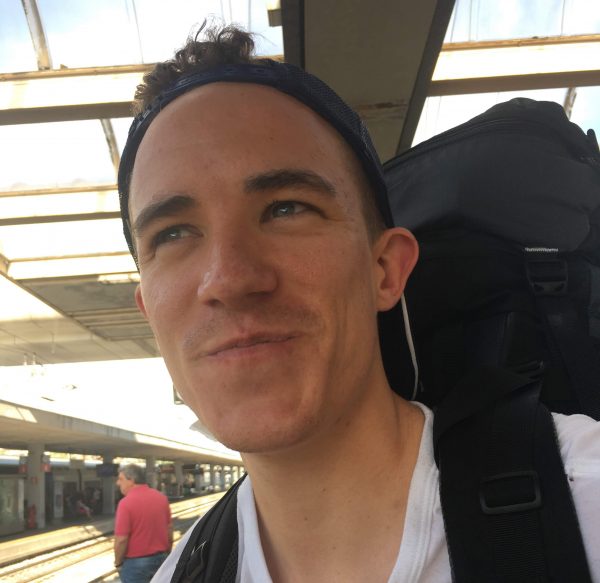Characterizing wetland development and infilling using GPR on North Stradbroke Island (Minjerribah), Australia

Dr. Allen Gontz
Professor, San Diego State University
Wednesday, October 7th, 2020
1 pm – watch Allen’s talk here
Abstract
Palustrine and lacustrine wetlands are often listed as components of “young” landscapes yet the world’s largest sand islands (Fraser (K’Gari), North Stradbroke (Minjerribah) and Moreton (Mulgumpin) Islands) which may be older than 1 Myr, all host numerous such wetlands. The wetlands on these islands are in dune morphosequences that have been shown to predate ~150 kya and previous work has dates from basal or near basal wetland sediments that exceed ~130 kya. So how does an island composed of mobile, unconsolidated sand host wetlands that are persistent and have existed through an entire glacial cycle?
During October 2018 and 2019, high-resolution and deep penetrating ground penetrating radar surveys were conducted over Brown Lake (Bummiera), Welsby Lagoon, Fern Gully and 18 Mile Swamp on North Stradbroke Island in an effort to better understand the context of several cores from these locations. An 80 and 160 MHz GPR system was hand dragged or vehicle towed around the margins of the sites to provide a geologic context of the basin. The 160 MHz GPR system was also hand dragged over wetland surfaces while both 80 and 160 MHz were rafted over open water for understanding water depth, sediment infill and pre-wetland basin morphology. The 80 MHz antenna was effective to below ground depths of 40 m on land and 25 m over water while the 160 was effective to 25 m over land and about 18 m over wetland sediment and water.
The surveys revealed a great deal of insight about the basins and infill. On the margins, there are clear examples of buried shoreline deposits that range from strandline beaches to prograding beaches and migrating dunes. Infilling sediments were observed to have characters that ranged from draped to ponded. Horizons of disturbance were observed throughout the wetland interval and thought to correlate to periods of burning observed as charcoal peaks in cores. Below the wetland units and on land surrounding, sedimentary units correlative to podsol soil sequences were observed.
Work is ongoing to correlate the GPR data with the sediment core archive to create a better understanding of the basin development as well as a better understanding of past water levels through mapping buried lowstand beaches and changes to depositional style observed on the GPR, but not visible at the sediment core scale. These insights will allow better conceptualization of the drivers of current wetland water regimes and climate controls on the system.
Lasting impressions of climate fluctuations at Brown Lake (Bummiera), North Stradbroke Island (Minjerribah), Australia

Sarina Mazzone
MS candidate, San Diego State University
Wednesday, October 7th, 2020
1:15 pm – watch Sarina’s talk here
Abstract
The sand islands off the coast of Australia are home to dune complexes exceeding ~800 kya. During times of lower sea level (~60-80 m), exposed shorelines and strong persistent winds created dune formations via aeolian deposition. The world’s second largest sand island, North Stradbroke Island (Minjerribah), is a noteworthy example to study paleoclimate because of the plethora of wetland systems. North Stradbroke Island (NSI) is located on the eastern boundary of Moreton Bay and hosts large, overlapping parabolic dunes. The sediment structure, former soil horizons, and well sorted sands –– coupled with a subtropical climate –– houses the necessary conditions for lacustrine environments to persist. Analyzing micro/macro fossil sequences from wetland sediment cores yields proxies for water availability, temperature, and the ecology of a specific area. However, proxies obtained from sediment cores are poor depictions of water level changes. The inclusion of ground penetrating radar (GPR) data is a useful addition to the stratigraphic context obtained from wetland sediment cores. The imagery provides direct evidence of past water level changes.
GPR has proven successful in evaluating paleoshoreline sequences of small, shallow lakes. Perched lake systems are unusual features of NSI and other sand islands. They are situated well above sea level and the regional water table and are characterized by shallow depths, small areas, and fluctuating basin size. Perched lake systems can dry during prolonged periods of dry climate. The largest perched lake on NSI is Brown Lake (Bummeria), which sits about ~25m above the regional water table.
On-going research has surveyed over 60 km of GPR data on NSI. At Brown Lake (Bummiera), two GPR frequencies 80 and 160 MHz have been used over water and land for a broader basin context. The major aims of this study are to map the extent of Brown Lake (Bummiera) to try and answer whether it has the capability to desiccate and identify past lake levels using geophysics and sequence stratigraphy. This will be done by connecting the GPR data, dated sediment cores, and known OSL dates. There is considerable concern over falling water levels at Brown Lake (Bummiera) during recent droughts. This study will provide better understanding of past water level changes and the interactions of Brown Lake (Bummiera) to the perched groundwater system that supports it.
Paleoenvironmental reconstruction of marine limestone of the upper Miocence Boleo Formation along the incipient Gulf of California in Central Baja, Mexico – Baja Basins 2020 IRES

Elyse Dilloway
BS Candidate, San Diego State University
Wednesday, October 7th, 2020
1:25 pm – watch Elyse’s talk here
Abstract
The limestone at the base of the Boleo Formation in the Santa Rosalia basin in Baja California Sur, Mexico developed along the nascent Gulf of California in late Miocene time. Little is known about the environment of deposition of this basal limestone. We measured the basal limestone where it is 2.5 m thick and overlies a sequence of late Miocene basaltic andesite flows and cobble conglomerate in the Caopas gypsum mine north of Santa Rosalia. Samples were collected for petrographic, XRD, SEM/EDS, and microfossil analyses. The base of the limestone is a laminated calcisiltite that contains algal laminations, fecal pellets, and micritic oncoids indicative of a low-energy, lagoonal environment. The presence of coated ooids suggests wave agitation and deposition in shoaling waters. This unit is overlain by a 0.5-m-thick dolostone that possibly replaced an earlier primary phase. Pores in the dolomite were coated with iron oxides, followed by incomplete coatings of Mn oxides, and finally with calcite. Up section, a 1.3-m-thick, fossiliferous calcisilite with some cross-bedding and abundant intraformational angular rip-up clasts, some in channels, record deepening water on a storm-dominated shelf. Genera identified in this unit include Globigerina, Globigerinoides, Bolivina (foraminifera), and Calcidiscus (coccolithophore). These genera are generally associated with upper bathyal water depths up to 200 m (Carreño, 1992). The uppermost 0.6 m is wave-ripple laminated calcarenite with pinch and swell structures suggesting a change to shallower water. In other locations, the basal limestone is capped by ~100 m of gypsum. The Boleo basal limestone at the Caopas outcrop records marine inundation and deepening from shallow to open marine shelf conditions that hosted calcareous foraminifers and nannoplankton. Alteration of the rock seen in the mineralization of the dolostone is related to the Mn and Cu ore deposits that began after the initial marine incursion. The change from open marine deposition to evaporitic conditions recorded in the overlying gypsum likely resulted from fault-controlled subsidence and structural segmentation that isolated the basin from open marine waters, while permitting inflow of saline waters that produced the thick evaporite sequence.
Can the lack of lake loading explain the earthquake drought on the southern San Andreas Fault?

Ryley Hill
PhD candidate, San Diego State University
Wednesday, October 7th, 2020
1:35 pm – watch Ryley’s talk here
Abstract
The last major rupture on the southern San Andreas Fault (SSAF) occurred in ca 1726. This ~300 year open interval is well beyond the observed quasiperiodic recurrence interval of ~150 years. The unexpectedly long open interval poses the question of whether or not there is a physical mechanism underlying the observed large ‘earthquake drought’ on the SSAF system. Recently refined paleoseismic evidence shows that variations in ancient Lake Cahuilla high-stands, a 236 km3 lake that loaded the SSAF with nearly 100 m of water, correlates with historical ruptures on the SSAF. Here, we build a fully coupled 3D poroelastic model of the SSAF system under the previous ~1000 year loading history of Ancient Lake Cahuilla to calculate Coulomb stress changes through time in the Salton Trough that contribute to the pre-existing tectonic loading (18 ± 1 mm/yr). We compute the spatiotemporal change in Coulomb stress with differing fault permeability structures to quantify the relative effect of elastic stress changes and pore pressure diffusion on the SSAF at depth through time. Our model demonstrates the effect of historical and present-day lake loading to quantify the modulation of the SSAF recurrence interval through time.
Holocene global warming driven by retreating ice-sheets and rising greenhouse gas concentrations

Dr. Samantha Bova
Assistant Professor, San Diego State University (Fall 2021)
Wednesday, October 7th, 2020
1:45 pm – watch Sam’s talk here
Abstract
Establishing a natural baseline for modern climate change is a fundamental goal for the global scientific community. As such, massive efforts have been undertaken to compile databases of records from across the globe spanning the past 10,000 years, starting with the Marcott et al. (2013) synthesis. Subsequent syntheses as recent as Kaufman et al., (2020), added hundreds of temperature sensitive proxy records, and refined the precision of these estimates, but generally agreed with the idea of warmer mean annual temperature at the early-mid Holocene followed by cooling to the present. These proxy-based reconstructions, however, are at odds with climate models that simulate robust warming throughout the Holocene in response to retreating ice sheets and rising greenhouse gas concentrations across the Holocene period. This model-data discrepancy, a. k. a. the Holocene Conundrum, suggests fundamental problems in proxy reconstructions, current climate models, or both, and inhibits an understanding of the driving forces behind recent climate changes. Here, we suggest a fundamental assumption that underlies global proxy temperature reconstructions, that most proxies record mean annual temperature rather than a particular season, is flawed. Using a new method that (1) identifies seasonal biases in individual proxy records and (2) converts seasonal to mean annual temperatures, we present a revised history of Holocene climate. We show that global mean annual temperatures have been rising since the early Holocene, first in response to retreating ice sheets and then in response to rising greenhouse gas concentrations. These findings therefore suggest the Holocene Thermal Maximum is a seasonal feature, driven by the early Holocene maximum in boreal summer insolation.

